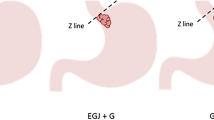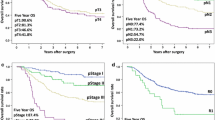ABSTRACT
Background
Adenocarcinoma of the esophagogastric junction (EGJ) is rapidly increasing in the west. Our aim is to define the prognostic factors and treatment of EGJ carcinoma in Mexico, particularly the location after the Siewert’s classification.
Methods
A retrospective cohort of patients suffering from EGJ adenocarcinoma treated from 1987 to 2000. The Kaplan-Meier and the Cox’s models were used to define prognostic factors.
Results
Two hundred and thirty-four patients were included, 90 females and 144 males. Surgical resection was possible in 68 cases only (29%). Significant prognostic factors were tumor node metastasis (TNM) stage [stages I–II: risk ratio (RR) is 1; stage III RR is 1.3, 95% confidence interval (CI) 0.75–2.4; stage IV RR, 2.04, 95% CI 1.1–3.7], gender (male RR = 1.47, 95% CI 1.05–2.05), metastatic lymph node ratio (no resection: RR = 1; ratio 0.2–1 RR=0.67, 95% CI 0.39–1.14; ratio 0–0.19 RR = 0.42, 95% CI 0.23–0.76) and seralbumin (3 mg/dL or less RR = 2.05 95% CI 1.3–3.2; 3.1–3.4 mg/dL RR = 1.9 95% CI 1.2–3.03; 3.5–3.8 mg/dL RR = 1.3 95% CI 0.8–1.9; 3.9 mg/dL or more: RR = 1) (model P = 0.0001).
Conclusions
EGJ adenocarcinoma is a highly lethal neoplasia and the location after the Siewert’ classification is not a prognostic factor. In Mexico, TNM clinical stage, serum albumin, gender, surgical resection and metastatic lymph node ratio are significant prognostic factors. Curative treatment is infrequent but radical resection is associated to longer survival. Consequently, the management must consider quality of life and surgical morbidity.






Similar content being viewed by others
References
Jankowski JA, Perry I, Harrison RF. Gastro−oesophageal cancer: death at the junction. Understanding changes at molecular level could lead to screening opportunities. Br Med J 2000; 321:463–464
Corley DA, Buffler PA. Oesophageal and gastric cardia adenocarcinomas: analysis of regional variation using the cancer incidence in five continents database. Int J Epidemiol 2001; 30:1415–1425
Corley DA, Kubo A. Influence of site classification on cancer incidence rates: an analysis of gastric cardia carcinomas. J Natl Cancer Inst 2004; 96:1383–1387
Navarrete-Alemán J, Oñate-Ocaña LF, Herrera-Goepfert R, Zamora-Varahona J, Mondragón-Sánchez R, Aiello-Crocifoglio V. Factores pronósticos en una cohorte de pacientes con carcinoma esofágico. Rev Gastroenterol Mex 2004; 69:209–216
Oñate-Ocaña LF. Gastric cancer in Mexico. Gastric Cancer 2001; 4:162–164
Siewert JR, Stein HJ. Classification of carcinoma of the esophagogastric junction. Br J Surg 1998; 85:1457–1459
Fein M, Fuchs KH, Ritter MP, Freys SM, Heimbucher J, Staab C, Thiede A. Application of the new classification for cancer of the cardia. Surgery 1998; 124:707–714
Kodera Y, Yamamura Y, Shimizu Y, Torii A, Hirai T, Yasui K, Morimoto T, Kato T. Adenocarcinoma of the gastroesophageal junction in Japan: relevance of Siewert’s classification applied to 177 cases resected at a single institution. J Am Coll Surg 1999; 189:594–601
Mariette C, Castel B, Toursel H, Fabre S, Balon JM, Triboulet JP. Surgical management of and long-term survival after adenocarcinoma of the cardia. Br J Surg 2002; 89:1156–1163
DeMeester SR. Adenocarcinoma of the esophagus and cardia: a review of the disease and its treatment. Ann Surg Oncol 2006; 13:12–30
Greene FL, Page DL, Fleming ID, Fritz A, Balch CM. American Joint Committee on Cancer. AJCC Cancer Staging Manual, 6th ed. New York: Springer-Verlag, 2002
Duly EB, Grimason S, Grimason P, Barnes G, Trinick TR. Measurement of serum albumin by capillary zone electrophoresis, bromocresol green, bromocresol purple, and immunoassay methods. J Clin Pathol 2003; 56:780–781
Mazumdar M, Glassman JR. Categorizing a prognostic variable: review of methods, code for easy implementation and applications to decision.making about cancer treatments. Statist Med 2000; 19:113–132
Kaplan EL, Meier PM. Nonparametric estimation from incomplete observations. J Am Stat Soc 1958; 53:457–481
Bland JM, Altman DG. The logrank test. Br Med J 2004; 328:1073
Feinstein AR. Proportional hazards analysis (Cox regression). In: Multivariable analysis: An introduction. New Haven CT: Yale University Press (1996) pp 370–397
Siewert JR, Feith M, Werner M, Stein HJ. Adenocarcinoma of the esophagogastric junction: results of surgical therapy based on anatomical/topographic classification in 1,002 consecutive patients. Ann Surg 2000; 232:353–361
Siewert JR, Feith M, Stein H. Biological and clinical variations of adenocarcinoma at the esophago-gastric junction: relevance of a topographic.anatomic subclassification. J Surg Oncol 2005; 90:139–146
Oñate-Ocaña LF, Aiello-Crocifoglio V, Gallardo-Rincon D, et al. Serum albumin is a significant prognostic factor for patients with gastric carcinoma. Ann Surg Oncol 2006; 13(2):S35. DOI 10.1245/s10434-006-9093-x
Lien YC, Hsieh CC, Wu YC, et al. Preoperative serum albumin level is a prognostic indicator for adenocarcinoma of the gastric cardia. J Gastrointest Surg 2004; 8:1041–1048
Forones NM, Mandowsky SV, Lourenco LG. Serum levels of interleukin-2 and tumor necrosis factor-alpha correlate to tumor progression in gastric cancer. Hepatogastroenterology 2001; 48:1199–1201
Bauer J, Herrmann F. Interleukin-6 in clinical medicine. Ann Hematol 1991; 62:203–210
Ashizawa T, Okada R, Suzuki Y ,et al. Clinical significance of interleukin-6 in the spread of gastric cancer: role of IL-6 as a prognostic factor. Gastric Cancer 2005; 8:124–131
Krijgsman B, Papadakis JA, Ganotakis ES, Mikhailidis DP, Hamilton G. The effect of peripheral vascular disease on the serum levels of natural anti-oxidants: bilirubin and albumin. Int Angiol 2002; 21:44–52
Kunisaki C, Akiyama H, Nomura M ,et al. Developing an appropriate staging system for esophageal carcinoma. J Am Coll Surg 2005; 201:884–890.
Kunisaki C, Shimada H, Nomura M, Matsuda G, Otsuka Y, Ono H, Akiyama H. Clinical impact of metastatic lymph node ratio in advanced gastric cancer. Anticancer Res 2005; 25:1369–1375.
Bonavina L, Ferrero S, Midolo V, Buffa R, Cesana B, Peracchia A. Lymph node micrometastases in patients with adenocarcinoma of the esophagogastric junction. J Gastrointest Surg 1999; 3:468–476
Oñate-Ocaña LF, Aiello-Crocifoglio V, Mondragón-Sánchez R, Ruiz-Molina JM. Survival benefit of D2 lymphadenectomy in patients with gastric adenocarcinoma. Ann Surg Oncol 2000; 7:210–217
Ormsby AH, Goldblum JR, Rice TW, Richter JE, Gramlich Tl. The utility of cytokeratin subsets in distinguishing Barrett’s-related oesophageal adenocarcinoma from gastric adenocarcinoma. Histopathology 2001; 38:307–311
Hardwick RH, Williams GT. Staging of esophageal adenocarcinoma. Br J Surg 2002; 89:1076–1077
Dolan K, Sutton R, Walker SJ, Morris AI, Campbell F, Williams EM. New classification of oesophageal and gastric carcinomas derived from changing patterns in epidemiology. Br J Cancer 1999; 80:834–842.
Wijnhoven BP, Siersema PD, Hop WC, van Dekken H, Tilanus HW. Adenocarcinomas of the distal oesophagus and gastric cardia are one clinical entity. Rotterdam Oesophageal Tumor Study Group. Br J Surg 1999; 86:529–535
Steup WH, De Leyn P, Deneffe G, van Raemdonck D, Coosemans W, Lerut T. Tumors of the esophagogastric junction. Long-term survival in relation to the pattern of lymph node metastasis and a critical analysis of the accuracy or inaccuracy of pTNM classification. J Thorac Cardiovasc Surg 1996; 111:85–95
Ito H, Clancy TE, Osteen RT, Swanson RS, Bueno R, Sugarbaker DJ, Ashley SW, Zinner MJ, Whang EE. Adenocarcinoma of the gastric cardia: what is the optimal surgical approach? J Am Coll Surg 2004; 199:880–886
Hulscher JBF, van Sandick JW, de Boer AGEM et al. Extended transthoracic resection compared with limited transhiatal resection for adenocarcinoma of the esophagus. N Engl J Med 2002; 347:1662–1669.
Walsh TN, Noonan N, Hollywood D, Kelly A, Keeling N, Hennessy TP. A comparison of multimodal therapy and surgery for esophageal adenocarcinoma. N Engl J Med 1996; 335:462–467
Macdonald JS, Smalley SR, Benedetti J, et al. Chemoradiotherapy after surgery compared with surgery alone for adenocarcinoma of the stomach or gastroesophageal junction. N Engl J Med 2001; 345:725–730
Cunningham D, Allum WH, Stenning SP, for the Magic Trial participants. Perioperative chemotherapy versus surgery alone for resectable gastroesophageal cancer. N Engl J Med 2006; 355:11–20
Acknowledgments
Many thanks to Ms Blanca Rosas Rosas and to Maria Esther Briones Trejo for their invaluable help with the logistics of this research. Many thanks also to Alejandra García Hubard for her help in the writing of the manuscript and to Maggie Brunner, M.A. for her English language editorial review.
Author information
Authors and Affiliations
Corresponding author
Rights and permissions
About this article
Cite this article
Oñate-Ocaña, L.F., Milán-Revollo, G., Aiello-Crocifoglio, V. et al. Treatment of the Adenocarcinoma of the Esophagogastric Junction at a Single Institution in Mexico. Ann Surg Oncol 14, 1439–1448 (2007). https://doi.org/10.1245/s10434-006-9216-4
Received:
Revised:
Accepted:
Published:
Issue Date:
DOI: https://doi.org/10.1245/s10434-006-9216-4




